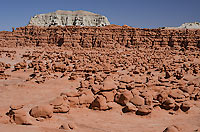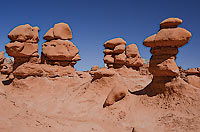Hiking Distance: Walk as far as you like
Difficulty: Easy
Fees: $13 Day Use Fee to enter the park
When you take your first peek at Goblin Valley from the overlook, you’ll understand why early settler Arthur Chaffin named this area “Mushroom Valley.” A miner by trade, Chaffin came across Goblin Valley in the 1920s while searching for an alternate route between Green River and Caineville. From a vantage point about a mile away, he and his two companions could see this lowland area full of strange rock formations and surrounded by eroded cliffs. _CMYK.jpg)
Although records indicate that cowboys had stumbled upon the area earlier while searching for lost cattle, Chaffin’s “discovery” of Mushroom Valley was instrumental in eventually preserving the area as a state park. Years passed after his first visit, but he never forgot the fantastic view he had seen.
In 1949 Chaffin finally returned and spent several days photographing the hoodoo rock formations that had captured his attention some 20 years earlier. As his photos began to circulate, word got around about the valley of mushroom rocks, and visitors began to flock to the area. To protect the unique area from potential vandalism, the State of Utah established Goblin Valley State Preserve, which became Goblin Valley State Park in 1964.
A Martian Landscape
The stage was set for Goblin Valley’s mushroom-shaped rocks about 170 million years ago when the area was covered by a shallow sea. When higher areas eroded away, the resulting sand and silt was carried down and deposited in a wide tidal flat, creating layers of sandstone separated by layers of shale and siltstone. As the weaker shale and siltstone 
disintegrated, the harder sandstone was left to be molded by water, wind, and ice into the fascinating shapes you see here today. Erosion continues today, and the goblins will eventually collapse when their supporting pedestals wear away. Many of the boulders you see lying on the ground are the remains of fallen goblins.
As you wander among the weirdly shaped rocks, it’s not hard to imagine that you’re roaming around another planet. In fact, the area near Hanksville and Goblin Valley is the stage for the University Rover Challenge, an annual robotics competition hosted by the Mars Society in which university teams design and build Mars rovers. Goblin Valley’s “mushrooms” have also been discovered by Hollywood. Portions of the 1999 film Galaxy Quest were shot here to portray an alien planet, and in 2010 an area not far from Goblin Valley served as the Martian landscape in the film John Carter.
Goblin Valley is a must-do stop if you’re traveling with children. I don’t think there’s a kid on the planet who wouldn’t gladly give up their video games to spend a day scrambling through the maze of hoodoos here. So, if you’ve been on the road for days and fear your children are turning into car zombies, a stop at Goblin Valley is guaranteed to bring them back to life. In fact, you may have to drag them out kicking and screaming when it’s time to leave.
Hite Crossing Bridge
Getting Goblin Valley on the map wasn’t Arthur Chaffin’s only claim to fame—he was actually better known for building the Hite Ferry in 1946. This vehicle ferry at the tiny settlement of Hite was one of the few places in the region where people could cross the Colorado River, making it possible to travel by vehicle between Hanksville and Blanding. The ferry operated for 20 years until the waters of Lake Powell buried Hite in the late 1960s.
If you head south on SR 95 from Hanksville for about 47 miles, you’ll cross the modern version of the Hite Crossing Bridge. The scenic arch bridge is the only automobile crossing of the Colorado River between Moab (110 miles upstream) and the Glen Canyon Bridge (185 miles downstream). Be sure and stop at the Hite Overlook View Area for a distant view of the bridge and a panorama of Lake Powell and the Colorado River.
Getting There
From Moab (100 miles): Head north from Moab on Hwy 191 for 31 miles to I-70. Turn left to merge onto I-70 west and continue for 33 miles to Exit 149 for UT-24. Head south on UT-24 for about 24 miles, and turn right at the signed turnoff to Goblin Valley State Park (Temple Mountain Road). Drive for 5 miles and then turn left onto Goblin Valley Road. Continue 6.3 miles to the entrance and fee station; from there, it’s a little over 1 mile to Observation Point.
|
_CMYK.jpg)

